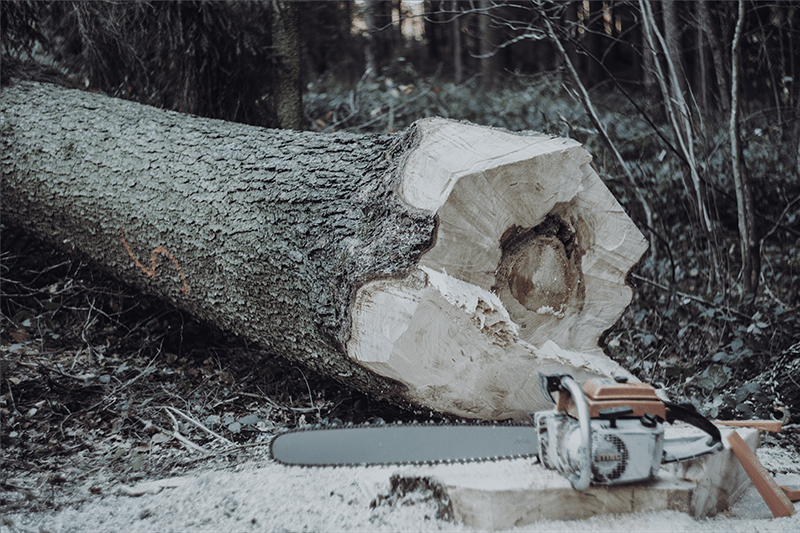
Over the last half decade, there have been frequent reports of fuel geysering accidents. Particularly between 2017 and 2018, there were a total of 54 reported fuel geyser incidents. Out of this figure, 43 were chainsaw incidents.
A 2015 report by the Bureau of Land Management identified possible pressurization hazards associated with systems on 12 models of chainsaws.
Out of 28 fuel geyser accidents reported in 2018, 23 of these were caused by chainsaws. There are many questions surrounding this, including, why is it that chainsaws are seemingly more prone to geyser accidents?
Before we examine these thoughts further, let’s explore the definition of a fuel geyser.
There is an infrequent forceful expulsion associated with liquid fuel tanks that occurs as a result of rapid depressurization-it is called “Fuel Geyser”. It happens when heat from the engine warms the fuel during operation and the fuel cap is suddenly opened, releasing a splash of heated fuel. Here’s what it looks like in action:
This incident could occur while using any of the following:
2015:
We’ll examine a review submitted by the Bureau of Land Management, a near miss involving an MS460 Stihl Chainsaw in 2015. Although no injuries were recorded, The Forest Service National Technology and Development Centre was called in to conduct an analysis and give a report. In the initial report, the Centre found that:
But what is the position today?
2017:
Sometime in 2017, the STIHL MS 461, a chainsaw often used by firefighters was recalled by the Consumer Product Safety Commission (CPSC) along with three other STIHL models that were at risk of fire and burn hazards. According to the report published by Widlfiretoday, there were 117 reports of pinched or leaking fuel lines. In particular, MS 461 was cited to have the problem of vapor lock which can result in dying engine. In an event that the gas cap is removed to check the fuel level, a fuel geyser may occur.
2018:
According to The Wildland Fire Lessons Learned Centre, only last year, 23 of 28 reported geyser accidents were caused by chainsaws. 21 of these incidents involved Stihl saws. The BLM and other agencies are trying to figure out why fuel geysers occur and how to prevent these accidents. There has been a list of guidelines laid out for the Sawyer, to help him avoid geyser accidents but one can never be too careful. Of importance would be the regulations, laws and recommendations surrounding the production of these particular chainsaws that have the newer quarter-turn gas caps. As these seem to be more accident prone compared to the older style of threaded caps.
Fuel Geyser Testing
The foregoing reports lead us to the issue of ‘Testing”. The National Wildfire Coordinating Group has an ongoing project called the “National Fuel Geyser Project”. This Project focuses on studying fuel geyser incidents, proffering solutions and giving safety guidelines. Currently the Project is conducting a field evaluation of vaporless refueling systems. This would be done using 50 test crews and 30,000 refueling cycles to be implemented on all handheld fuel powered engines.
Alternative solutions highlighted include –
This project is ongoing and we remain positive that there will be solutions within a reasonable time. In the meantime, what are your options if you suffer a fuel geysering incident?
Conclusion
As it is your duty to keep yourself and everyone around you safe you must take necessary precautions against fuel geyser incidents. But are there instances where you have taken every reasonable precaution but still got hurt through no fault of yours? If you find yourself in this situation you should contact a personal injury lawyer to examine the possibilities.
Contact us for a free case evaluation here.
Please do not attempt to determine if you have a compensable case. You must consult a farm and agricultural products liability attorney who has expertise and extensive knowledge on determining who ultimately caused the harm and injuries you or a loved one suffered in this terrible tragedy.
Sources:
 Top Truck Accident Lawyer in Pasadena
Top Truck Accident Lawyer in Pasadena Best of The Best Attorneys
Best of The Best Attorneys Best of the Best Houston Chronicle 2021
Best of the Best Houston Chronicle 2021 Best Motorcycle Accident Lawyers in Houston 2021
Best Motorcycle Accident Lawyers in Houston 2021 American Association for Justice Member
American Association for Justice Member The National Trial Lawyers 2016 – (Top 40 under 40)
The National Trial Lawyers 2016 – (Top 40 under 40) Multi-Million Dollar Advocates Forum 2016 (Top Trial Lawyer)
Multi-Million Dollar Advocates Forum 2016 (Top Trial Lawyer) Million Dollar Advocates Forum 2019 (Top Trial Lawyer)
Million Dollar Advocates Forum 2019 (Top Trial Lawyer) America’s Top 100 Attorneys 2020 (High Stake Litigators)
America’s Top 100 Attorneys 2020 (High Stake Litigators) Lawyers of Distinction 2019, 2020 (Recognizing Excellence in Personal Injury)
Lawyers of Distinction 2019, 2020 (Recognizing Excellence in Personal Injury) American Institute of Personal Injury Attorneys 2020 (Top 10 Best Attorneys – Client Satisfaction)
American Institute of Personal Injury Attorneys 2020 (Top 10 Best Attorneys – Client Satisfaction) American Institute of Legal Advocates 2020 (Membership)
American Institute of Legal Advocates 2020 (Membership) Association of American Trial Lawyers 2018 - Top 100 Award recognizing excellence in personal injury law
Association of American Trial Lawyers 2018 - Top 100 Award recognizing excellence in personal injury law American Institute of Legal Professionals 2020 (Lawyer of the Year)
American Institute of Legal Professionals 2020 (Lawyer of the Year) Lead Counsel Verified Personal Injury 2020
Lead Counsel Verified Personal Injury 2020 The Houston Business Journal 2021
The Houston Business Journal 2021